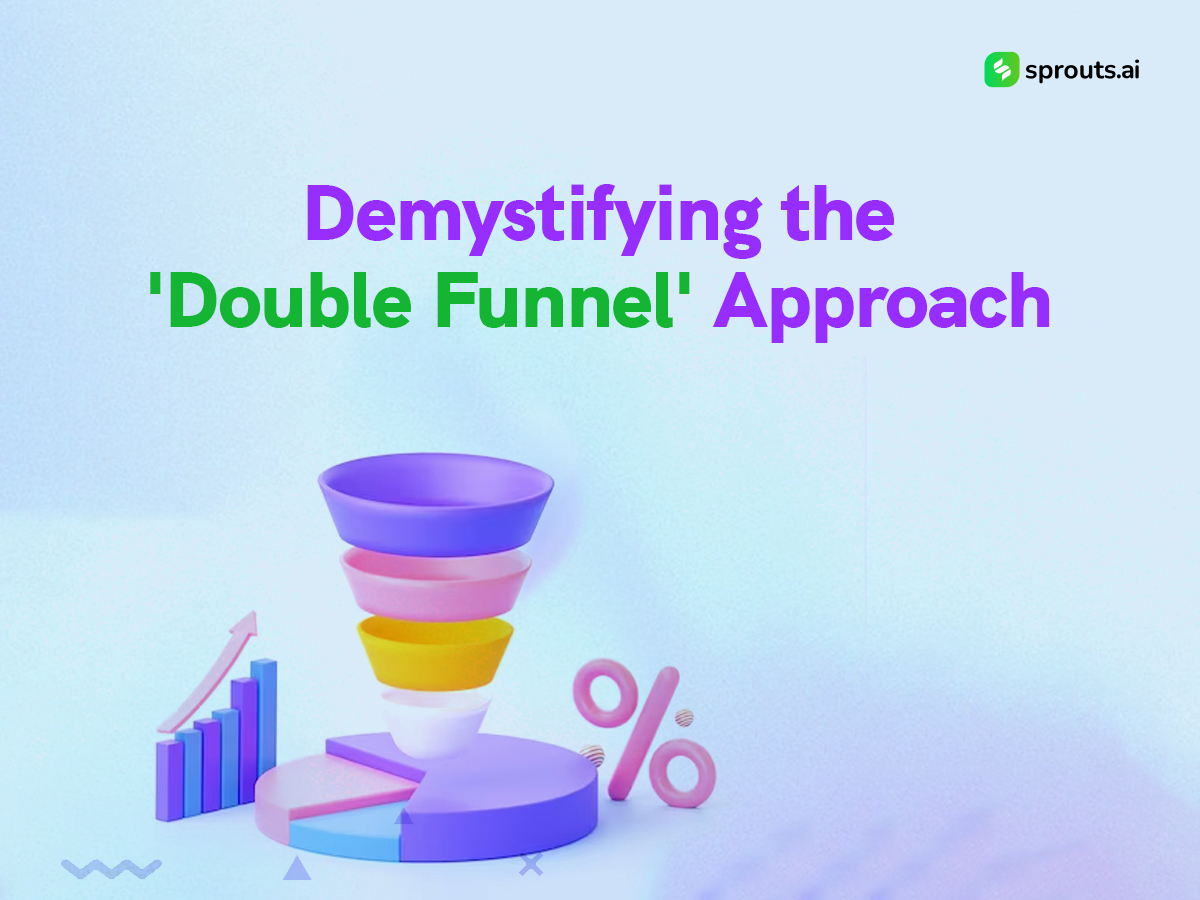Marketing strategies and methodologies change at the drop of a hat. One of the latest strategies that is being talked about is the “Double Funnel” approach. But what exactly is it, and does it live up to the hype? Let’s discuss!
The Double Funnel Unveiled
The Double Funnel approach is a contemporary marketing strategy that reimagines the traditional sales funnel model. It debates the notion that the journey from brand discovery to conversion is a process that takes time and effort.
This strategy details the complexity of modern consumer behavior, where customers often follow a non-linear path influenced by various touchpoints and channels.
Traditional vs. Double Funnel: To better understand this concept, let’s compare it to the conventional sales funnel. Traditionally, the funnel consists of stages like Awareness, Consideration, Conversion, and Retention, with customers linearly moving through these stages. The Double Funnel, however, adds an extra layer that focuses on account-based marketing (ABM) alongside the traditional lead funnel.
In the Double Funnel, you still nurture individual leads through the same stages, but at the same time, you apply a parallel ABM strategy to engage key accounts directly. This second funnel targets high-value accounts with personalized messaging and marketing, prioritizing relationship-building and tailoring solutions to specific business needs.
The Double Funnel approach gives businesses the flexibility to combine broad outreach with highly focused account-level engagement, driving both volume and value. The result is a more dynamic process that helps accelerate sales velocity, improve deal sizes, and enhance customer relationships.
Separating Myths from Facts
Myth #1: The Double Funnel is All About New Customers
One common misconception is that the Double Funnel approach is solely focused on acquiring new customers. While it helps attract and convert new leads, it also emphasizes retaining existing customers. Nurturing existing customers can be more cost-effective than constantly chasing new ones.
Myth #2: The Double Funnel is Only for Big Businesses
Some may assume that the Double Funnel approach is reserved for large corporations with extensive resources. However, it can be applied by businesses of all sizes. Smaller businesses may need to scale down their strategies, but the fundamental principles remain applicable.
Fact #1: Integration of the Upper and Lower Funnels
The Double Funnel approach integrates the “Brand Funnel” and the “Performance Funnel.” The Brand Funnel mirrors the conventional Awareness to Consideration stages, while the Performance Funnel represents the Consideration to Conversion stages. This integration allows marketers to take a holistic view of the customer journey, understanding how branding efforts impact performance marketing and vice versa.
Fact #2: The Customer’s Non-Linear Journey
Understanding the Double Funnel starts with recognizing that today’s consumers sometimes follow a linear path. They might jump back and forth between awareness and consideration or even skip stages altogether. This complexity highlights the need for a more flexible and adaptable marketing approach.
Fact #3: The Role of Data and Personalization
One of the key strengths of the Double Funnel approach lies in its reliance on data and personalization. Marketers can use data to understand where customers are in the funnel and tailor their messaging accordingly. Personalization can significantly enhance the customer experience, increasing the likelihood of conversion.
Fact #4: Cross-Channel Synergy
Another significant aspect of the Double Funnel is its recognition of the importance of cross-channel synergy. More is needed to have a strong presence on one platform. Marketers must ensure that their branding and performance efforts across various channels are cohesive and complementary.
Fact #5: Measuring Success Differently
With the Double Funnel approach, success isn’t solely measured by the number of conversions. Marketers also assess brand awareness, engagement, and customer loyalty metrics. A comprehensive view of success helps in making informed decisions and optimizing strategies.
Fact #6: Evolving with the Customer Journey
One of the strengths of the Double Funnel approach is its adaptability. As consumer behavior and preferences evolve, so can your strategy. This flexibility is crucial in the ever-changing world of digital marketing.
Initiating a Paradigm Shift
The Double Funnel approach challenges marketers to break free from traditional linear thinking and embrace a more dynamic and customer-centric perspective. By understanding the facts and dispelling the myths surrounding this strategy, you can begin to harness its potential. Here are some steps to initiate a paradigm shift within your marketing team:
- Educate Your Team: Start by educating your marketing team about the Double Funnel approach. Ensure everyone understands the concept and its implications for your specific industry.
- Map Customer Journeys: Create customer journey maps that reflect the non-linear nature of the Double Funnel. Identify touchpoints and channels that are most relevant to your audience.
- Invest in Data Analytics: Make data analytics a priority. Invest in tools and resources to effectively collect, analyze, and act upon customer data.
- Personalization Strategy: Develop a personalization strategy that tailors messaging and content to different stages of the Double Funnel. This can significantly enhance the customer experience.
- Collaboration Across Teams: Foster collaboration between branding and performance marketing teams. Encourage open communication and shared goals to ensure a cohesive approach.
- Continuous Learning: Recognize that the digital landscape is constantly changing. Encourage a culture of constant learning and adaptation within your marketing department.
The Double Funnel approach is not just a buzzword; it’s a paradigm shift in how we view and engage with customers. By demystifying the concept and separating fact from fiction, marketers can harness its power to create more effective and customer-centric strategies. Embrace the Double Funnel, adapt to the evolving customer journey, and watch your marketing efforts yield meaningful results.

